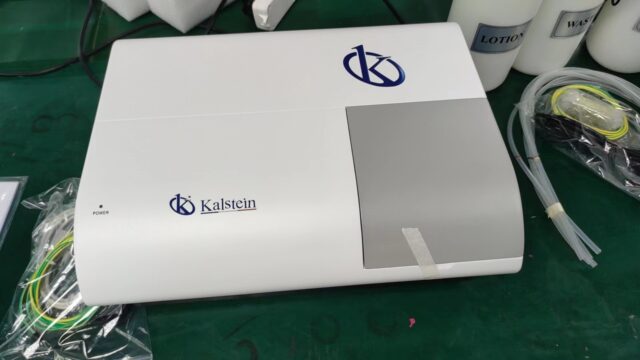Microplate readers, (plate readers or microplate photometers) are used to detect biological, chemical or physical events of samples in microtiter plates. Microplate readers are widely used in the pharmaceutical and biotechnical industry, quality control and academic organizations. There are different types of detection modes detection modes for microplate assays, such as absorbance (ELISAs, enzyme activity, and nucleic acid and protein quantification), fluorescence intensity, luminescence, time-resolved fluorescence (TRF), and polarization.
Absorbance
Absorbance is used for assays such as ELISA assays, protein and nucleic acid quantification or enzyme activity assays. This process is based on transmitting light: a light source illuminates the sample (with specific wave light) and a light detector on the other side of the well measures the percentage of light transmitted through the sample. The amount of transmitted light is related to the concentration of the molecule of interest.
Fluorescence
The range of applications of fluorescence intensity is much broader than absorbance detection. In this type of instrumentation, a first optical system (excitation system) illuminates the sample using a specific wavelength. The sample emits light (it fluoresces) and a second optical system (emission system) collects the emitted light and measures the signal using a light detector.
Luminescence
A typical luminescence optical system consists of a light-tight reading chamber and a PMT detector. The best reader for this method is a Photon Counting, which detects luminescent.
Time-resolved fluorescence (TRF)
Time-resolved fluorescence (TRF) measurement is very similar to fluorescence intensity measurement, but with the timing of the excitation/measurement process. When measuring FI, the excitation and emission processes are simultaneous: the light emitted by the sample is measured while excitation is taking place.
Fluorescence polarization
Fluorescence polarization is similar to fluorescence, but it includes polarizing filters on the light path. This implies that the samples are excited using polarized light. The light emitted will either be polarized or not depending on the mobility of the molecules found in the wells. A low level of polarization indicates that small fluorescent molecules move freely in the sample. A high level of polarization indicates that fluorescent is attached to a larger molecular complex.
Microplate Reader
The YR411 Microplate Reader, with a wavelength range of 340–750nm, is a high-performance solution for a wide range of applications, including immunoassays with colourimetric substrates, such as ELISA, and protein assays such as Bradford and Lowry. It is designed for applications within the clinical, biotechnology research and pharmaceutical laboratory. The YR411 can be used as a stand-alone reader or be controlled by a PC or a PAD with Android system. It reads various kinds of 96-wells plates and is equipped with shaking function. If you want to get more information about Microplate readers, please follow this link: Microplate Reader
Microplate Washer
The YR410 Microplate Washer model is easy, convenient and versatile to use for washing microplates in ELISA assays. It efficiently removes liquid from wells, it has low residual volumes that eliminate high background signal to ensure reliable assay results. To get more information about the Microplate Washer YR410, follow this link: HERE

